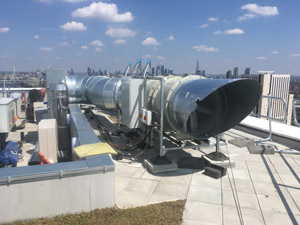Fire safety has never been as important within the Built Environment as it is currently, the period ‘post-Grenfell.’ Although it is now over 18 months since that tragic disaster, it could be argued that nothing has changed within the industry. Sure the ‘race to the bottom line’ is no longer one of the prime objectives and Dame Judith Hackett has reported what most in the Fire Sector already knew, that some kind of regulatory framework is required to oversee and monitor the safety aspects of all buildings throughout their lifetimes.
The major building contractors have beefed up their Health & Safety Departments and introduced senior executives with responsibility for fire safety. In-house Fire Officers of large corporations and organisations are having their voices heard and contracts for the upgrading of fire safety measures are being rushed through. This is of course how it should be, and the specialists in fire engineering, fire prevention and fire risk assessments have never been busier, but is it all just more of the same?
Every building, regardless of its use, size, contents or occupants, has rooms containing higher fire risks than other rooms. Fire Risk Assessments can identify these higher risk areas, but proposing practical solutions for the protection of these compartments can be, and is often, problematic. A thorough understanding of three key areas of competence and expertise is required; namely active and passive fire protection and smoke control. These are three widely differing fields.
Active fire suppression is not always appropriate for all high risk areas. Passive fire protection is vital for containing fire spread but doesn’t necessarily prevent the smoke from escaping into adjacent rooms or corridors. The control and management of the smoke is key as its debilitating, toxic nature is well-documented.
Understanding smoke behaviour and how to control smoke is an area of specialist knowledge which straddles both active and passive fire safety. The quality of Fire Risk Assessments is generally on the increase and their recommendations carry a higher level of authority. Remedial works tend to be carried out by companies that specialise in either passive or active fire safety solutions. Recognised levels of certification can give assurances as to the competences of both the products and installers and with compliant fire stopping, early warning fire detection, alarms and suppression the risk can be managed. However in a fire incident there can be no guarantees that there will be no breaches of compartmentation!
Fire safety measures can provide an engineered solution for the management of the identified risks, yet the levels of understanding of smoke control is something of a grey area where very few specialists in this most important of fields exist. Pursuing solutions for protecting high risk areas without an understanding of how smoke will behave in a fire incident could be overlooked leading to the possibility of smoke logging, potentially compromising the means of escape. A smoke control system, in conjunction with both active and passive fire safety measures, can often provide a practical solution for managing the smoke risks. Compliant measures can be installed with minimal structural alterations to the fabric of the premises.
Any existing smoke control systems must be examined during the Fire Risk Assessments. Do they comply with current standards and are they capable of coping with a modern fire incident? Current fire loadings could be remarkably different to when the building was designed and constructed which could have a direct impact on the adequacy of the smoke control system in an incident. During recent surveys of NHS premises we found several instances of failed Automatic Opening Vents (AOVs – designed to automatically open in a fire incident) or mechanical smoke vents positioned incorrectly. Both could cause severe smoke logging in a fire incident and had been problematic for the Fire Officers to satisfactorily resolve.
A well-designed smoke exhaust system involves a complex mathematical and scientific calculation. A series of vents and dampers, controlled in unison, deliver a balanced flow of negative and positive air pressures to ensure a controlled air flow, thereby attaining optimum smoke extraction. Controlling the extraction of the smoke from the compartments will inhibit the pressurised lateral spread of smoke and heat, not only assuring the calm evacuation of the building but also assisting the emergency services in their operational duties.
Grenfell Tower was a major disaster; however the majority of fatalities in fire incidents are in low rise, often single storey premises, where the toxic smoke quickly contaminates the limited space available. All smoke control systems should be integral to the building’s fire alarm control panel, activated by the fire and smoke detectors with a link to the Building Management System. This will provide important information about the incident for the emergency services on arrival.
T +44 (0)1580 200198
info@ashfire.co.uk
www.ashfire.co.uk

